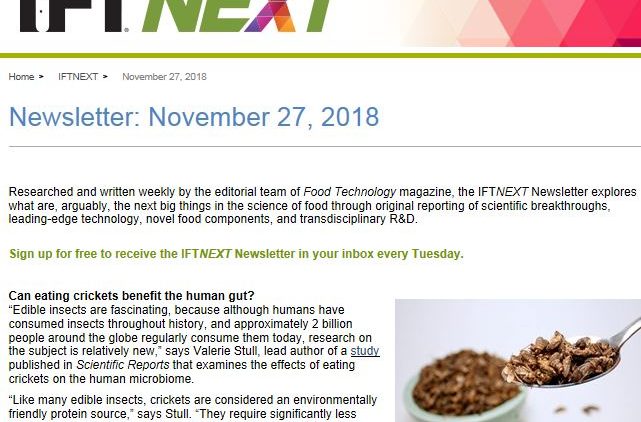
Researched and written weekly by the editorial team of Food Technology magazine, the IFTNEXT Newsletter explores what are, arguably, the next big things in the science of food through original reporting of scientific breakthroughs, leading-edge technology, novel food components, and transdisciplinary R&D.
Can eating crickets benefit the human gut?
“Edible insects are fascinating, because although humans have consumed insects throughout history, and approximately 2 billion people around the globe regularly consume them today, research on the subject is relatively new,” says Valerie Stull, lead author of a study published in Scientific Reports that examines the effects of eating crickets on the human microbiome.
“Like many edible insects, crickets are considered an environmentally friendly protein source,” says Stull. “They require significantly less feed, land, and water to survive and thrive than traditional livestock, while also emitting fewer greenhouse gases.” The species Gryllodes sigillatus, which was used in Stull’s study, is also high in protein and a good source of fiber.
Stull and her colleagues at the University of Wisconsin–Madison set up a double-blind, randomized, crossover clinical trial to evaluate the effects of consuming 25 g of whole cricket powder per day. “We aimed to do three things,” she explains. “Confirm that cricket consumption is safe and tolerable, see if eating edible crickets influences human health directly by changing lipid metabolism or markers of inflammation, and assesses if cricket fibers, such as chitin—the primary component of the exoskeleton—could be prebiotics.”
A total of 20 healthy adults participated in the six-week dietary intervention. Participants were randomized into two study arms and consumed either cricket-containing or control breakfast foods for 14 days, followed by a washout period and assignment to the opposite treatment. Blood and stool samples were collected at baseline and after each treatment period to assess changes in blood chemistry, liver function, and shifts in microbiota.
Following the study, the researchers saw no signs of toxicity or intolerability for participants after eating crickets. No changes in lipid metabolism were observed, but there was a slight increase in alkaline phosphatase and a decrease in circulating pro-inflammatory cytokine TNF-alpha with cricket consumption. “These results are suggestive of an improvement in intestinal homeostasis,” says Stull, “meaning that eating crickets may improve gut health and reduce systemic inflammation; however, more research is needed to understand these effects and underlying mechanisms.
“We also observed several changes in microbiota after eating cricket powder, including a prebiotic effect,” she adds. Specifically, the researchers measured a significant increase in Bifidobacterium animalis, a probiotic known to inhibit pathogens, improve gastrointestinal function, and protect against diarrhea and foodborne pathogens.
Stull believes the study speaks to the potential health benefits of insect consumption, but advises that additional research is warranted, with larger sample sizes and an evaluation of the impact of cricket consumption on gut microbiota as well as the potential risks from eating insects.
“Food science researchers are currently looking more closely at insect protein digestibility, properties of protein hydrolysates, potential bioactive peptides, ways to reduce allergenicity, and how to integrate insect powders into a wide variety of food products,” she notes. “My hope is that food scientists will also explore the properties of insect fibers.”
Delayed irrigation improves walnut crop quality, optimizes water use
For most California walnut growers, irrigating early in the season to preserve the deep moisture that walnut trees are thought to require in order to flourish over the course of a hot, dry summer is standard practice. But scientists from the University of California, Davis, working with a grower, have shown that subjecting the trees to a certain degree of stress by limiting their water supply early in the season results in a better yield—and optimizes water use.
What they found is that watering the trees heavily in the spring prevents them from developing the deep roots they need to thrive. “Trees end up with a very shallow root system, which doesn’t serve them well as they try to extract moisture from the soil later on,” says Bruce Lampinen, almond/walnut specialist in the University of California, Davis, Plant Sciences Dept. Lampinen devised the experiment, which got underway five years ago.
Over the years, the researchers worked with five groups of trees. One group was irrigated on the standard early watering schedule, and for the others, irrigation was initiated at different times based on when the trees reached different levels of water stress. The researchers used air pressure devices called pressure chambers to determine how hard walnut trees were working to extract water from the soil. The scientists looked at water extraction from the soil at different depths and found that the trees with delayed-start irrigation treatments were extracting moisture from lower depths and also had less stress from lack of water in the fall when irrigation is cut off for harvest. This suggests that they have deeper roots, Lampinen explains.
The trees that did the best were those for which irrigation was started in mid-to-late June, which is several weeks later than normal, causing them to experience a moderate degree of stress. “This information is very useful for growers,” says Lampinen. “By delaying the start of irrigation in the spring until the trees tell you they need water (using the plant pressure chamber), growers can likely conserve water and improve overall tree health.” In addition, he says, the researchers found that trees kept slightly less wet had improved nut quality.
Walnut grower Hal Crain says this approach is working in his orchard, which was selected for the test because of its lower-than-optimal yield. “When you irrigate based on your trees’ needs, you optimize water. I’m not using less water overall, but the water I do use is producing more food,” says Crain.
The research project received funding from the California Walnut Board and the U.S. Dept of Agriculture. In addition to the work by UC Davis plant sciences researchers, it was supported by an irrigation advisor with the University of California Cooperative Extension program.
What we eat may affect how gut bacteria communicate
The tiny bacteria that make up the human body’s microbiome are studied for the big roles that they may play in health. Some of the latest insights into the microbiome have helped scientists gain an understanding into how bacteria respond to the food we eat. The study is published in Science Advances.
The study examined how the generation of glucose from the food we eat affect a bacterial signaling process called quorum sensing. During the process, individual bacteria secrete small signaling molecules called autoinducers. The autoinducer signals build up, and when they reach a certain threshold, they are transported intracellularly, according to the study. When this happens, the signals activate gene expression.
“Our group has been working together for several years, and a long-term goal of ours is to elucidate the molecular communication pathways that govern physiological processes and link bacteria with human cells,” says William E. Bentley, a professor in the Fischell Dept. of Bioengineering at the University of Maryland, and a corresponding author of the study. “In biology, information transfer—and the way organisms’ function—depends entirely on ‘communicating’ molecules that move information back and forth among cells and tissues. The ‘talk’ between bacteria and human cells is complex, but virtually important. Studies such as these will form the basis for new antimicrobial therapies and could even shape diet plans and exercise regimens to improve human health.”
